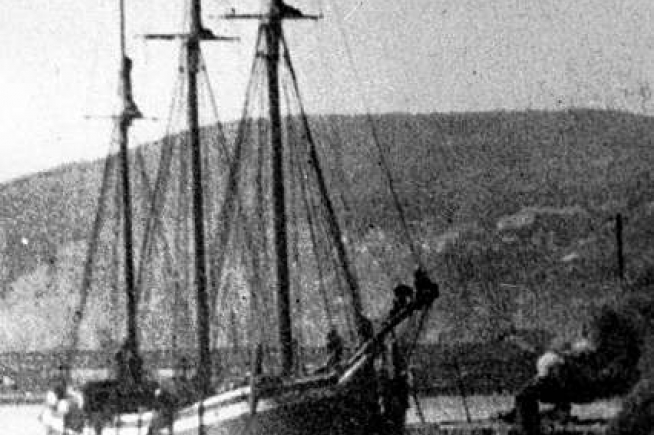Samuel P. Ely – Schooner Barge 1869-1896 (SHIPWRECK)
Samuel P. Ely – Schooner Barge 1869-1896 (SHIPWRECK)
Two Harbors MN
The Samuel P. Ely, U.S. Registry 23780, was a single-decked, three-masted topsail schooner measuring 200 feet in length, with a 31-foot beam (width), and a 13-foot depth of hold. The Elywas rated at 627,24 gross tons and 595.85 net tons, with a carrying capacity of 1,200 tons. The original configuration of the ship’s deck cannot be ascertained with certainty because no engineering plans or builders’ drawings are known to exist. However, the Ely has been compared with other schooners of the type and period by using historic photographs. Photographs suggest the ship had four or five cargo hatches in the deck, each measuring approximately 8 feet square. The ship is also known to have had three masts. A low deck-house at the stern was customary, usually “sunken” into the deck 3 feet or 4 feet, so that it projected above deck level about the same distance.
The Ely was constructed in 1869 at the J.P. Clark Shipyard, Springwells, Mich., and represents the type of vessel constructed around 1870 for the shipment of iron ore. Having both integrity of wreck site and structure, the Ely represents the most complete example of the 200-foot schooner that has been found in Lake Superior. The Ely was fairly typical of Lakes sailing craft of the 1860s and 1870s, although perhaps of more sturdy build than most of its contemporaries. The vessels in the ore business were reinforced with very powerful framing members and extra bracing. The Ely shows powerful framing members with extra bracing, the latter in the form of vertical hold stanchions, hold beams, and heavy knees. The Ely was wrecked in 1896 against the west breakwater in Agate Bay, Two Harbors, Minn. The port of Two Harbors is on the North Shore of Lake Superior, 23 miles north of Duluth, Minn.. As a result of repairs and additions made to the breakwater, the shipwreck is partially embedded in its rubble mound.
The Wind Blew at Near 50 Miles an Hour
At the end of October, 1896, the Samuel P. Ely made a trip to Duluth in tow of the Hesper, a 250-foot steamer, along with the Negaunee, a similar barge. Both barges were loaded with limestone from Kelley’s Island, Ohio. The steamer had a coal cargo. The three ships passed up through the Sault Locks on October 24 and arrived at Duluth on the 27th. After discharging its coal, the Hesper shifted over to the grain elevators to take on wheat for Buffalo, while the two barges unloaded their limestone and waited for a tow to Two Harbors to load ore. Together, the three left Duluth on the morning of October 29th.
The events surrounding the Ely’s loss are best summarized in contemporary newspaper accounts. The Duluth Daily News, Oct. 30, 1896, reported:
Last night was the wildest night that has closed on Duluth in eleven years. The wind blew at the rate of 48 to 50 miles an hour, and the rain that had fallen with considerable persistency all that afternoon came down in torrents nearly all night. Through the streets dashed blinding sheets of spray. No vessels have left the harbor since yesterday morning, [and] there will be no vessels to leave till the storm abates….
The Duluth Evening Herald, Oct. 30, 1896, gave the following account of the Ely’s loss.
The schooner Samuel P. Ely left Duluth at 11 o’clock yesterday morning in tow of the steamer Hesper. Ordinarily the boats would have reached Two Harbors at 1 or 2 o’clock at the latest, but they had to encounter a heavy head wind and a high sea, and it was 8 o’clock last evening before they arrived at Two Harbors.Here the highest sea in the memory of the inhabitants was on, and the boats experienced much difficulty in getting in. The Hesper was hardly able to care for herself, and apparently it was necessary for her to throw off her consorts line. At any rate this was done, and while the Hesper steamed safely in, the schooner was immediately placed in a dangerous position. The Ely’s towline had been cast off before the tug could reach it, and though schooner dropped its anchors, it drifted rapidly and the anchors dragged uselessly. At midnight the Ely was hard on the breakwater in grave danger of going to pieces, as the sea pounded it against the breakwater.
The Ely gave the tug a line, but it parted immediately, and both the schooner and the crew were in immediate danger. A scow also went on the breakwater, and the two men who made up its crew took refuge on the schooner.
At 3 o’clock this morning the schooner sank alongside the breakwater, and the men had scarcely time to get into the rigging. All attained a hold in the rigging, however, and while their position was little improved, they had staved off death by drowning, at least for awhile.
It was still dark when the men got into the rigging. The wind was high, the sea was terrific, and the rain and the waves dashed against the men until they were wet through and numbed with cold. When day broke the men were all there, and the people of Two Harbors lined the shore and looked helplessly at the awful scene. No plan for rescue seemed apparent at first, as it was impossible for a tug to reach the men without being dashed upon the breakwater, too.
Finally, a plan was suggested which proved feasible. The tug Ella G. Stone took 200 feet of line and let a small sailboat drift slowly to the wreck. A few of the men got aboard, and the sailboat was dragged back to the tug. Three such trips were necessary before the men were all rescued but it was successfully accomplished. The task of rescuing the men on the wreck was attended with great danger and it was performed heroicly. There were ten men on the Ely, eight forming the crew and two from the scow which went on the breakwater.
The Ely is probably damaged considerably; how much is not known. Her masts project from the water, she was unloaded. She is 200 feet long, 32 feet beam, 14 feet depth, and was built in 1869 at Detroit. She is owned by M. A. Bradley of Cleveland.
Another article in the Duluth Evening Herald, Oct. 30, 1896, commented on a different aspect of the story.
The (Duluth) Life Saving crew received a call at 3 o’clock this morning to go to Two Harbors to the assistance of the crew of the Ely, which was driven on the breakwater at that place last night. It was three hours before the life savers succeeded in getting their apparatus across the Canal. It was found necessary to haul the outfit to a point east of the old merchandise dock owning to the fact that the Duluth & Iron Range Railway tracks were blocked with wreckage of the dock and pilings. It was 7 o’clock in the morning before all was ready for the run by rail up to Two Harbors, and at that time a message was received that the Ely’s crew had all been taken off.
The Duluth News Tribune, Oct. 31, 1896, summarized the event the following day:
The northeast gale that swept the head of the Lakes spent its fury yesterday afternoon, and the freshwater Neptune was appeased. It will be recorded as the most furious gale that has visited this end of the Lakes for a decade.So far as is known at the present, the only danger to life was on board the schooner Ely, which was wrecked on the breakwater at Two Harbors. This was a thrilling experience for the crew, and the danger and exposure through which they passed is graphically described by eye witnesses.
It is feared that the Ely will be a total loss. She is an old vessel and by coincidence was named for one of the founders of the Minnesota Iron Company, and who at present is heavily interested in that concern and its kindred operations.
The Detroit Free Press, October 31, 1896, reported that a wrecking outfit was being sent to strip the wreck for her owners, and it commented that the ship was only insured for one-fifth of its value. The Ely was worth some $12,500 at the time. No details of the subsequent salvage work have yet been found, but it is presumed that the ship’s three masts were removed, along with all of the related rigging, sails, and tackle. It does not appear that any effort was made to recover its deck machinery. The wreck was not regarded as a hazard to navigation on account of its location in the harbor, and so it was not blown up nor removed from the site of the sinking.
Samuel P. Ely Detailed Information MN historical Society Shipwreck Map
All Content the property of MN Historical Society and Sources.


